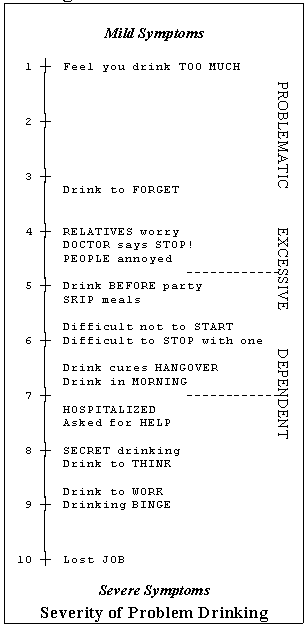
Problem drinking. Wright BD. … 1995, 8:4 p.402
Presenting an interval scale as a portrait communicates far more meaning than a mere list of test items. Cornel at al. (1994) go to great pains to construct a Rasch-based statistically valid interval scale for the severity of problem drinking. Then they forget to present their useful scale to the reader in an easily understood, insightful manner.
The "Problem Drinking" construct mapped in the Figure is based on the information they give about their final selection of 18 test items. It positions the predictable stages in the problem drinker's deterioration into alcohol enslavement. As such, it is useful to clinicians, researchers, and even to drinkers because it points out that apparently trivial symptoms are indicators of doom.

This Figure, however, extrapolates beyond the information supplied in the published paper. That paper neglects to provide either item calibrations or the relevant sample size that would enable the reader to estimate the item calibrations conveniently. The Figure uses a reasonable sample size estimate based on the reported item raw scores. The reported item text has also been summarized and, for two items, reversed in wording in order to clarify the construct.
Sophisticated methodology and statistical rigor are powerful steps along the way to scientific advancement, but without clear communication, even Herculean effort subsides into another forgotten report destined for the round filing cabinet. It is forceful portraits that stay alive in our minds.
Cornel M, Knibbe RA, van Zutphen WM, Drop MJ. 1994. Problem drinking in a general practice population: the construction of an interval scale for severity of problem drinking. Journal of Studies on Alcohol 55(4) p. 466-470. July.
Problem drinking. Wright BD. … Rasch Measurement Transactions, 1995, 8:4 p.402
| Forum | Rasch Measurement Forum to discuss any Rasch-related topic |
Go to Top of Page
Go to index of all Rasch Measurement Transactions
AERA members: Join the Rasch Measurement SIG and receive the printed version of RMT
Some back issues of RMT are available as bound volumes
Subscribe to Journal of Applied Measurement
Go to Institute for Objective Measurement Home Page. The Rasch Measurement SIG (AERA) thanks the Institute for Objective Measurement for inviting the publication of Rasch Measurement Transactions on the Institute's website, www.rasch.org.
| Coming Rasch-related Events | |
|---|---|
| Jan. 16 - Feb. 13, 2025, Fri.-Fri. | On-line workshop: Rasch Measurement - Core Topics (E. Smith, Winsteps), www.statistics.com |
| Apr. 8 - Apr. 11, 2026, Wed.-Sat. | National Council for Measurement in Education - Los Angeles, CA, ncme.org/events/2026-annual-meeting |
| Apr. 8 - Apr. 12, 2026, Wed.-Sun. | American Educational Research Association - Los Angeles, CA, www.aera.net/AERA2026 |
| May. 15 - June 12, 2026, Fri.-Fri. | On-line workshop: Rasch Measurement - Core Topics (E. Smith, Winsteps), www.statistics.com |
| June 19 - July 25, 2026, Fri.-Sat. | On-line workshop: Rasch Measurement - Further Topics (E. Smith, Winsteps), www.statistics.com |
The URL of this page is www.rasch.org/rmt/rmt84n.htm
Website: www.rasch.org/rmt/contents.htm